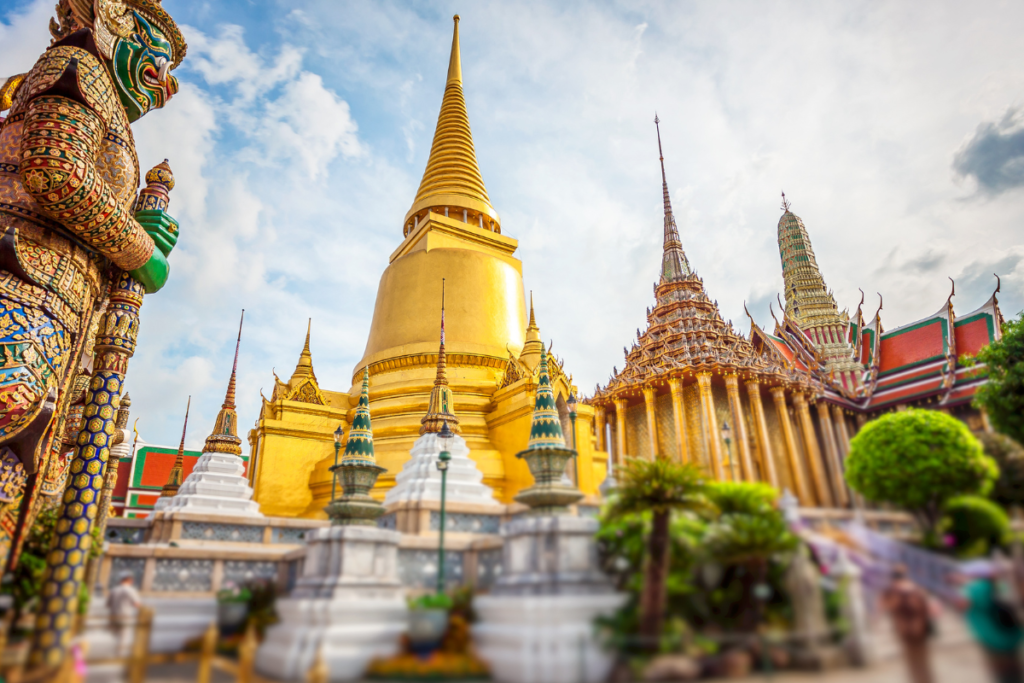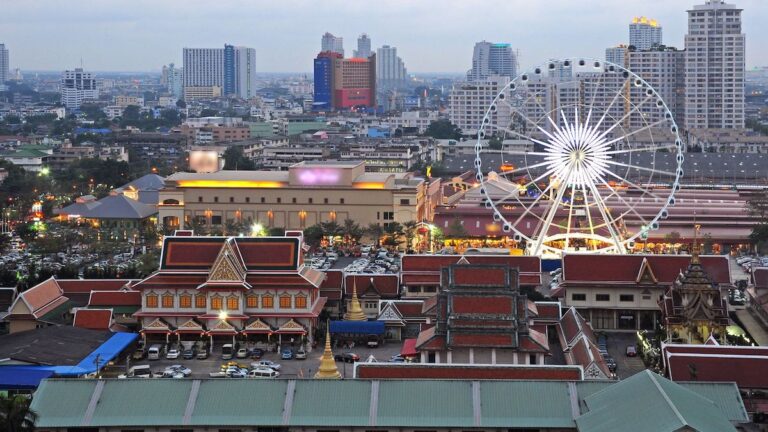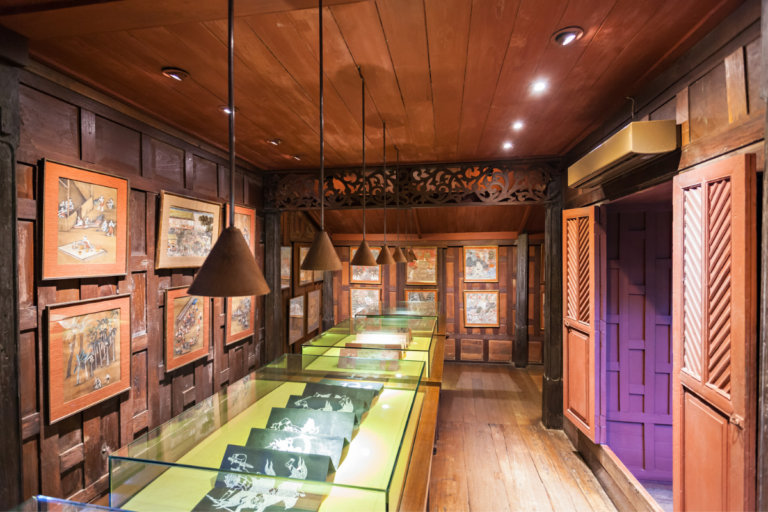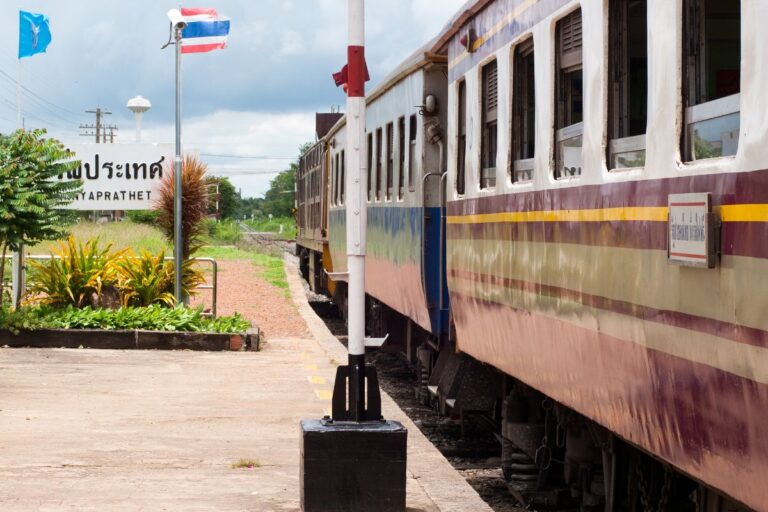Grand Palace Bangkok
Nestled in the vibrant heart of Thailand’s capital city, this magnificent palace is more than just a pretty facade. It’s a dazzling display of architectural prowess, cultural heritage, and enough historical tales to make your head spin. Beyond the architectural splendor, the Grand Palace Bangkok is a living testament to Thai culture and tradition. Visit the Grand Palace to experience customs, rituals, and beliefs that have shaped Thai society.
The Grand Palace complex in the old part of Bangkok is probably the most well-known landmark in the entire city. It is a stunning collection of temples and important artifacts and sits close to the banks of the Chao Phraya River. The Grand Palace is a must-see, with the Emerald Buddha as its main highlight.
The palace’s Thai title is Phra Borom Maha Ratcha Wang and it has grown immensely over the years to include various departments of government. Although the Thai government is no longer run from the palace, the Grand Palace remains the spiritual heart of the country.
History of the Grand Palace
The palace hails from the late 1700s and used to be the main residence of Thai kings, up until King Chulalongkorn (Rama V) decided to move into nearby Dusit Palace. Contrary to popular belief, the current king (Bhumibol Adulyadej – Rama IX) also does not live here – His Majesty resides in Chitlada Palace on the Dusit grounds.
✨ BEST GRAND PALACE TOURS
The Grand Palace was built under King Rama I – the first king of the current Chakri Dynasty – when he settled across the river, away from Thonburi, into the old Bangkok of today. It was about this time that Bangkok was being established on the move of power from Ayutthaya and its themes and forms represent the style of palace of Thailand’s former illustrious capital.
Buildings in the Grand Palace Complex
Within the vast grounds of the Grand Palace Bangkok, you will find a treasure trove of many architectural wonders and sacred temples. Here are some of the notable buildings and temples we recommend to see during your visit.
The Temple of Emerald Buddha (Wat Phra Kaew)

The whole place is full of stunning structures, with the Wat Phra Kaew complex having the most impressive ones. There are loads of classical Thai temples here that are in the Rattanakosin style, with Wat Phra Kaew itself having the greatest allure. Inside it is the Emerald Buddha image, which is said to be originally from India and was gifted to Thailand by Cambodia in the 1400s.
The Grand Palace covers a huge area of Rattanakosin Island and the walls are a couple of kilometers around. The entrance is along the north boundary along Naphralan Road, which is where the main tourist sights reside within the complex. The bottom half is out of bounds to visitors and is home to various royal palaces.
You enter near the Outer Court from Naphralan Road, with the Central Court to the south and the Temple of the Emerald Buddha (Wat Phra Kaew) off to the east (left). The King’s old residence was in the Central Court, parts of which remain open to tourists during weekdays. The closed-off section known as the Inner Court is beyond the Central Court.
Adjacent to Wat Phra Kaew is the Grand Palace Hall, which is as grand as can be from the outside. The stunning reception room of the Grand Palace Hall is decked out in a European style. The Amarinda Hall is another Grand Palace highlight and was home to King Rama I when he first had the palace built. The original throne is in here.
Dusit Maha Prasat Throne Hall
As you explore further, you’ll come across this exquisite building with its distinctive triple-tiered roof. This grand throne hall is a testament to Thai craftsmanship and houses the royal throne. Its regal exterior and meticulously designed interior reflect the profound cultural significance attached to this royal space.
Amarindra Winitchai Hall
This elegant hall serves as the venue for royal funerals and other important religious ceremonies. With its striking white exterior, intricate golden details, and sweeping tiered roof, it showcases the grandeur and solemnity associated with royal traditions.
Phra Mondop

Known as the Library Hall, Phra Mondop is a sacred repository for Buddhist scriptures and important religious texts. Its architectural design features four gabled roofs, adorned with ornate details and guarded by mythical creatures. This serene space is perfect for contemplation and reflection.
Boromabiman Hall
Also be sure to visit the Boromabiman Hall, which was built by King Rama VI, and the nearby Dusit Hall, one of the finest structures in the entire complex. In addition, the Grand Palace Museum is another top sight that tells all about the complex and has models of the palace.
Opening Hours and Admission
The Grand Palace opens every day of the week from 08:30 to 15:30. It may close on occasion for special functions so it is always worth checking ahead to be sure, and don’t take a tout’s word for it.
If you specifically want to see the Grand Palace audience halls, be sure to visit during the week as they shut up on weekends, while the Royal Pantheon in Wat Phra Kaew only opens on April 6.
The admission is quite steep and there are two separate prices: one for just the grounds of the Grand Palace and another, all-encompassing one that also takes in the Temple of the Emerald Buddha (Wat Phra Kaew). The larger fee also includes entry to Bangkok’s Vimanmek Mansion, which is the famous all-teak house that resides within the nearby Dusit Palace complex to the north of the Grand Palace.
Dress Code and Cultural Etiquette
Dressing appropriately when visiting the Grand Palace is a given and while many temples may be lax on this issue, the Grand Palace is strict. In short, covering legs and shoulders is a must and you cannot get away with wearing flip-flops unless you are wearing a pair of socks. Luckily, there is a booth near the entrance where folks can rent loose-fitting pants and tops.
Touts ply the streets near the entrance to the Grand Palace to try to get you to go on a guided tour of the city because the palace is closed. Never believe anything any random person on the street says, or a taxi driver for that matter. While there may be certain days when the Grand Palace is closed, it generally remains open year-round.
How to Get Here
Visitors staying on Khao San Road can actually walk to the Grand Palace complex in about 20 minutes, although this is not advised anywhere near midday because of the high heat and humidity. A popular way in is to take the Chaophraya Express Boat to nearby Tha Chang Pier. It is then a short walk east to the palace entrance, which is unmissable.
There are also bus stops nearby and you can of course take a taxi or tuk-tuk from anywhere in the city.
Frequently Asked Questions about the Grand Palace Bangkok
What is the Grand Palace Bangkok?
The Grand Palace Bangkok is a magnificent complex in the heart of Bangkok, Thailand. It serves as the official residence of the Thai royal family, a center for important ceremonies, and a symbol of the country’s rich history and cultural heritage.
Where is the Grand Palace located in Bangkok?
The Grand Palace is located on the eastern bank of the Chao Phraya River in the Phra Nakhon district of Bangkok, Thailand.
How do I get to the Grand Palace from downtown Bangkok?
You can reach the Grand Palace from downtown Bangkok by taking a taxi, tuk-tuk, or using public transportation such as the BTS Skytrain to Saphan Taksin station, then transferring to a Chao Phraya River boat to Tha Chang Pier, which is within walking distance of the palace.
What are the opening hours of the Grand Palace?
The Grand Palace is typically open for visitors from 8:30 am to 3:30 pm. However, it’s advisable to check the latest operating hours as they may be subject to change or temporary closures for royal events or ceremonies.
Is there an entrance fee to visit the Grand Palace Bangkok?
Yes, there is an entrance fee to visit the Grand Palace. The fee includes admission to the Grand Palace complex as well as the Temple of the Emerald Buddha.
Are there any dress code requirements to enter the Grand Palace?
Yes, there is a strict dress code at the Grand Palace. Visitors are required to dress modestly, covering their shoulders and knees. Avoid wearing revealing clothing, shorts, tank tops, or sleeveless shirts.
Can I take photographs inside the Grand Palace?
Yes, photography is generally allowed inside the Grand Palace, except in specific areas or during religious ceremonies where photography may be restricted. However, it’s important to be respectful and not use flash photography in sensitive areas.
Is there a guided tour available at the Grand Palace?
Yes, guided tours are available at the Grand Palace. You can join a guided tour organized by the palace authorities or opt for private tour guides who can provide detailed insights into the history and significance of the complex.
How long does it take to explore the Grand Palace?
The duration of your visit to the Grand Palace can vary depending on your pace and level of exploration. On average, visitors spend approximately 2 to 3 hours exploring the key attractions within the complex.
What are the main attractions within the Grand Palace complex?
The main attractions within the Grand Palace complex include the Temple of the Emerald Buddha (Wat Phra Kaew), the Chakri Maha Prasat Hall, the Dusit Maha Prasat Throne Hall, and the Phra Mondop (Library Hall), among others.
What is the significance of the Emerald Buddha?
The Emerald Buddha, housed within the Temple of the Emerald Buddha, holds immense religious and cultural significance in Thailand. The highly revered statue is considered the palladium of Thai monarchy and is believed to bring prosperity and protection to the country. It has been a symbol of national identity and the embodiment of Buddhism’s principles of compassion and enlightenment for centuries.
Can I visit the Grand Palace if I’m not interested in the religious aspects?
Absolutely! While the Grand Palace has religious significance, it is also a remarkable architectural and historical landmark. Even if you are not particularly interested in the religious aspects, you can still appreciate the intricate craftsmanship, stunning buildings, and captivating stories behind the palace’s construction and its role in Thai history.
Are there any restrictions or guidelines for behavior inside the Grand Palace?
Yes, there are guidelines for behavior within the Grand Palace to ensure a respectful and serene environment. Visitors are expected to dress modestly, refrain from touching artifacts, and maintain a quiet and solemn demeanor. Smoking, littering, and engaging in inappropriate behavior are strictly prohibited.
Are there places to eat or rest within the Grand Palace complex?
There are limited food and beverage options within the Grand Palace complex. It’s advisable to have a meal or snack before or after your visit. However, there are rest areas, benches, and shaded spots where you can take a break and soak in the ambiance of the palace surroundings.
Can I purchase souvenirs or gifts at the Grand Palace?
Yes, there are shops and stalls within the Grand Palace complex where you can find a variety of souvenirs, traditional handicrafts, clothing, and other gift items. These shops offer an opportunity to take home a piece of Thai culture and craftsmanship.
Is it necessary to book tickets in advance to visit the Grand Palace?
It is generally not necessary to book tickets in advance for regular visits to the Grand Palace. Tickets can be purchased at the entrance. However, during peak tourist seasons or public holidays, it may be advisable to check the availability and consider booking in advance to avoid long queues.
Are there any nearby attractions or sites to visit after exploring the Grand Palace?
Yes, the Grand Palace is located in the historic district of Bangkok, which offers several other attractions worth visiting. Nearby sites include Wat Pho, known for its giant reclining Buddha, Wat Arun (Temple of Dawn), the bustling market at Pak Khlong Talat, and the vibrant streets of Khao San Road, among others.
Is the Grand Palace accessible to individuals with mobility issues?
While the Grand Palace is a vast complex with uneven terrain and some staircases, efforts have been made to improve accessibility. Wheelchair access is available in certain areas, and there are paved paths in parts of the complex. However, it’s important to note that some areas may still pose challenges for individuals with mobility issues.
Can I visit the Grand Palace during religious ceremonies or special events?
During religious ceremonies or special events, the Grand Palace may have restricted access to the public or have altered visiting hours. It’s recommended to check the palace’s official website or contact the authorities beforehand to confirm availability and any specific guidelines during such times.
Is the Grand Palace open every day of the year?
The Grand Palace is typically open for visitors every day of the year, including weekends and public holidays. However, there may be occasional closures or adjusted opening hours due to royal events, maintenance, or unforeseen circumstances. It’s advisable to check the latest information before planning your visit.
Conclusion
The Grand Palace is more than just a collection of stunning buildings and temples; it’s a testament to the rich history, exquisite craftsmanship, and profound spirituality that permeates Thai culture.
From the moment you step foot within its ornate gates, you’re transported to a realm where the past and present seamlessly intertwine. The intricate architectural details of the Grand Palace and its vibrant colors create an atmosphere that is both enchanting and humbling.






